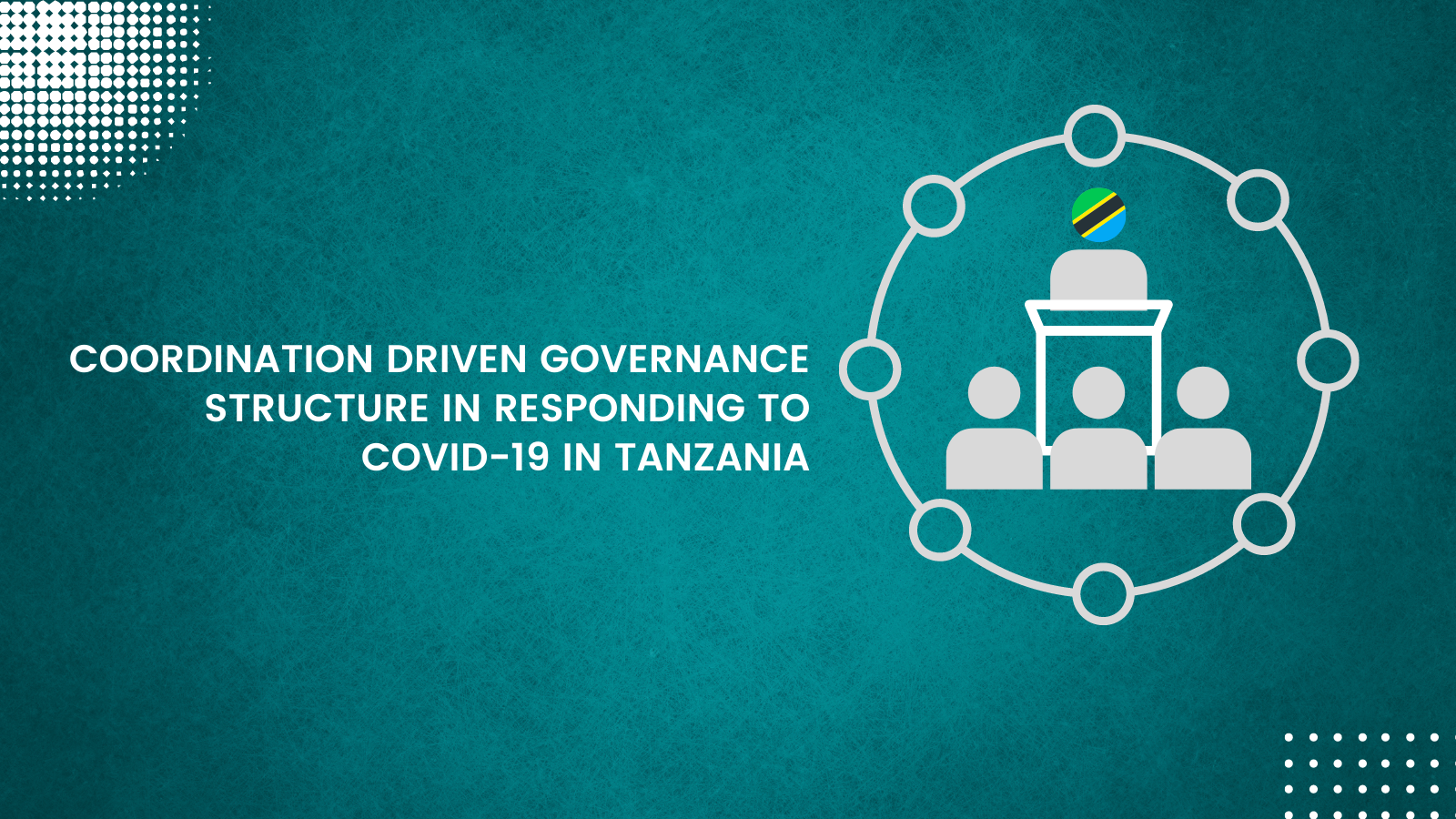By Dr. Otieno Osoro, Lecturer at University of Dar es Salaam, Department of Economics
The COVID-19 pandemic was considered a national emergency in Tanzania, which required an urgent and effective response. The pandemic brought about an urgent need for a coordinated response to meet the needs of the pandemic since it cut across many sectors in the country. As a result of this, Tanzania established a COVID-19 response governance structure that had coordination at its core to facilitate prompt decision making necessary during the pandemic.
Governance Structure
The Tanzanian Government formed three committees tasked with leading the fight against the COVID-19 pandemic. The first committee was the National Task Force headed by the Prime Minister that comprised of the Minister of Health, Ministers from other relevant ministries, and the Chief Government spokesperson. The second committee was the Committee of Permanent Secretaries headed by the Chief Secretary and comprising of permanent secretaries from relevant ministries, whose played an advisory role in the National Task Force. The third committee was the Technical Committee which was tasked with provision of technical advice to the Committee of Permanent Secretaries.
The Technical Committee was led by the Permanent Secretary, Ministry of Health, Community Development, Gender, the Elderly and Children who delegated this authority to the Chief Medical Officer. The Technical Committee had 11 sub-committees including operations, finance and administration, planning, logistics, case management, surveillance, testing, points of entry, health education, water, sanitation, and hygiene (WASH), and research. These sub-committees worked closely with the regional and district disaster management committees to maintain a well-coordinated response from the national to district level. Fig. 1 shows the COVID-19 response coordination framework.
Fig.1: COVID-19 Response Coordination Framework

The three committees were set up to facilitate a well-coordinated COVID-19 response that supported rapid decision making and implementation required to control the pandemic. These committees essentially formed a decision loop from district level to the National Task Force, which was the ultimate COVID-19 response decision making entity. The communication loop brought together the operational aspect of the response (Technical Committee) together with the policy level (National Task Force and Committee of Permanent Secretaries) to fast track decision making, planning and implementation that would not be possible under normal circumstances.
Governance Structure and Strategic Purchasing
The adjustment of the procurement and supply chain processes was the main role of the governance structure. This adjustment was necessary to facilitate flexible procurement and the supply of essential drugs and supplies which were initially slowed down by bureaucracy of normal procedures.
The adjustments required a total mindset shift and adoption of new ideas which made the Ministry of Health, Community Development, Gender, the Elderly and Children to introduce and facilitate the training of pharmacists, health officers, laboratory scientists, medical and clinical officers, and health secretaries on procurement, distribution, and storage of curative and preventive supplies.
In addition to the training, adequate support was provided to actualize the application of the training to respond to the peculiar demands of the pandemic response adequately. Procurement and distribution processes which were previously decentralized were centralized with the Ministry of Health, Community Development, Gender, the Elderly and Children undertaking procurement based on decisions made by the National Task Force. Similarly, procurement decisions were driven by technical advice from the Committee of Permanent Secretaries and the Technical Committee. Central procurement coordinated purchasing and avoided waste by matching needs with available supplies. Although decentralized procurement can also match needs and available supplies, it can at times fail to adequately respond to the demands of a pandemic, whose demands tend to be more national than local, hence the rationale for centralized procurement[DNO1] [DNO2] . The well linked coordination mechanism ensured centralized procurement had no serious bureaucracy issues during the pandemic. Centralized procurement was undertaken in the framework of the existing PFM laws with the major difference being that such procurement reduced delays by eliminating the various decentralized levels that required approval.
The Technical Committee via its sub-committees served as the interface where demand, procurement mechanisms, and distribution came together and achieved this through coordination of supply needs, receipt and validation of requests, review of requests against availability, confirmation of requests and purchase, and committing supplies for distribution. Response needs were aggregated from the district, regional to national level via demand forecasts for drugs, equipment, and supplies based on the inputs from providers at the various operational levels. Inputs were based on local needs, absorption capacity and gaps in unmet supply need. The demand forecasts were then submitted to the Committee of Permanent Secretaries which then presented them to the National Task Force for approval. The fact that the three committees were tightly integrated and were formed to enhance response coordination facilitated prompt decision making that could not have been achieved with decentralized procurement which has multiple approval processes. The multiple approval processes tend to be time consuming and are therefore inconsistent with the urgency of procurement demands of a pandemic[DNO3] .
The governance structure impact on procurement
Centralized procurement was based on more flexible demand forecasts emanating from providers to decide on what to purchase rather than the normal annual budget and planning cycles that lacked the flexibility to respond to emergencies like COVID-19. The coordination perspective of the three-committee governance structure offered prompt decision making and flexibility that could not have been achieved by decentralized budgeting, planning and implementation that had to go through various levels of scrutiny and approval. The three levels of committees offered the necessary coordination required for centralized procurement that responded to actual needs on the ground, i.e[DNO4] . bottom-up driven central decision making that integrated the needs of the entire country. Although members of sub-national government were not included in any of the committees, sub-national governments supplied inputs to sub-committees of the Technical Committee.
Distribution is a critical element of ensuring inputs are efficiently supplied and utilized in service delivery. Distribution of the centrally procured drugs, equipment and supplies was also managed centrally to quicken the process. Central distribution of procured items was streamlined and entailed scheduling delivery, arranging transport to regional medical officers who delivered to providers, informing requestors, and confirming receipt of items.
In addition to coordinating purchasing and distribution of essential commodities, the National Taskforce also responded to other commodities required for COVID-19 that were in high demand in the early days of the pandemic such as masks, hand sanitizers, and water buckets. The increased demand had led to a significant price increase of these items requiring the intervention of the National task force. The task force fast-tracked authorization for local manufacturers (large, medium, and small) to produce such items increasing their supply, and consequently resulted in price reductions that made the items more affordable to ordinary people.
Key take away for Tanzania The primary lesson Tanzania offers on the coordination of COVID-19 response is that a coordination framework that incorporates key operational and decision levels provides the flexibility and decisiveness required to respond to a pandemic effectively. This was achieved by having the Prime Minister of the United Republic of Tanzania lead the National Task Force that was the ultimate COVID-19 response decision making body in Tanzania. Apart from being responsible for disaster management, the Prime Minister’s Office is also responsible for coordination of government business implying the COVID-19 coordination framework in Tanzania was effectively capable of incorporating key operational and decision making levels that led to flexibility and prompt decision making necessary during a pandemic.

Dr. Otieno Osoro is a Lecturer in the School of Economics of the University of Dar es Salaam. Dr. Osoro specializes in health financing and has worked extensively on direct facility financing, planning and budgeting, and health resource tracking. Dr. Osoro has undertaken various assignments for the Ministry of Health, Community Development, Gender, Elderly and Children and international organizations.

